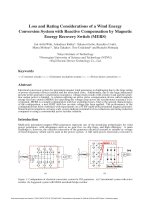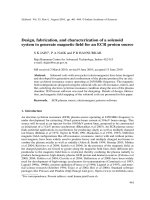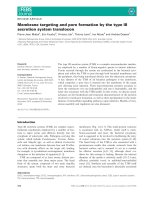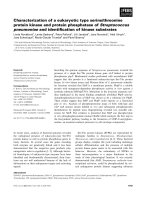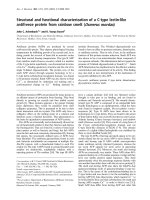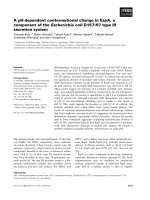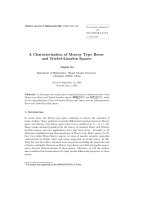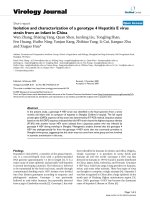Characterization of a type III secretion system and other virulence associated genes in aeromonas hydrophila
Bạn đang xem bản rút gọn của tài liệu. Xem và tải ngay bản đầy đủ của tài liệu tại đây (4.45 MB, 242 trang )
CHARACTERIZATION OF A TYPE III SECRETION
SYSTEM AND OTHER VIRULENCE-ASSOCIATED GENES
IN AEROMONAS HYDROPHILA
BY
YU HONGBING (BM)
A THESIS SUBMITTED
FOR THE DEGREE OF DOCTOR OF PHILOSOPHY
DEPARTMENT OF BIOLOGICAL SCIENCES
NATIONAL UNIVERSITY OF SINGAPORE
2006
i
ACKNOWLEDGEMENTS
I am indebted to my supervisor, Associate Professor Leung Ka Yin, for his invaluable
guidance, encouragement, patience, and trust throughout my study in the lab. I am grateful
to him for teaching me critical thinking and writing skills.
Many thanks to Associate Professor Pan Shen Quan and Associate Professor Sanjay
Swarup for their helpful advice and suggestions for my research work. Special thanks to
Prof. Juan M. Tomas, Prof. Peter Howard, Prof. Jin Shouguang and Prof. Ilan Rosenshine
for providing me with bacterial strains and supplying valuable suggestions for my research
work.
I am extremely grateful to Mr. Shashikant Joshi, Ms Wang Xianhui, Ms Kho Say Tin and
Ms Mok Lim Sum from the Protein and Proteomics Centre for their ready assistance in my
protein work. I would also like to extend my sincere thanks to Ms Bee Ling and Ms Liu
Chy Feng for their help in DNA sequencing.
A great deal of credit goes to the following people for their assistance in my experiments:
Ms Lau Yee Ling, Ms Rasvinder Kaur D/O Nund Singh, Ms Tung Siew Lai, Ms Lim
Simin, Ms Lee Hooi Chen, Mr. Li Mo, Ms Yao Fei, Ms Tan Yuen Peng, Mr. Zheng Jun,
Dr. Sirinivisa Rao, Dr. Yamada and Dr. Seng Eng Khuan.
I also thank Alan John Lowton, Sun Deying, Tu Haitao, Qian Zhuolei, and other friends in
the department for helping me in one way or another during the course of my project.
Last, but not least, I would like to thank my family members for their constant
encouragement and support for my work.
ii
TABLE OF CONTENTS
ACKNOWLEDGEMENTS i
TABLE OF CONTENTS ii
LIST OF PUBLICATIONS RELATED TO THIS STUDY x
LIST OF FIGURES xi
LIST OF TABLES xiv
LIST OF ABBREVIATIONS xvi
SUMMARY xviii
Chapter I. Introduction
1
I.1 Taxonomy and identification of Aeromonas hydrophila
1
I.1.1 Taxonomy 1
I.1.2 Identification 2
I.2 A. hydrophila and its infection
4
I.2.1 A. hydrophila infections in fish 4
I.2.2 A. hydrophila infections in humans 5
I.2.3 A. hydrophila infections in other animals 7
I.3 Virulence factors of A. hydrophila
8
I.3.1 A. hydrophila structure related virulence factors 8
I.3.1.1 S-layers 8
I.3.1.2 Flagella 9
iii
I.3.1.3 Capsules 10
I.3.1.4 Pili 11
I.3.2 A. hydrophila extracellular enzymes and toxins 12
I.3.2.1 Hemolysins and enterotoxins 12
I.3.2.2 Endotoxins 14
I.3.2.3 Proteases 15
I.3.2.4 Lipases 16
I.3.2.5 Chitinases 17
I.3.2.6 Siderophores 19
I.4 Genomic islands and pathogenicity islands
20
I.5 Type III secretion systems
22
I.5.1 Protein secretion systems in Gram-negative bacteria 22
I.5.2 Type III secretion systems and pathogenicity islands 25
I.5.3 Type III secretion system in animal pathogens 27
I.5.3.1 Yersinia species TTSS 27
I.5.3.1.1 Genetic organization and regulation 27
I.5.3.1.2 Secreted proteins 28
I.5.3.2 Pseudomonas aeruginosa TTSS 31
I.5.3.2.1 Genetic organization and regulation 31
I.5.3.2.2 Secreted proteins 32
I.5.3.3 Aeromonas salmonicida TTSS 34
iv
I.6 Objectives
35
Chapter II. Common materials and methods
37
II.1 Bacterial strains, plasmids and buffers
37
II.2 Fish studies
37
II.2.1 Animal model and maintenance
37
II.2.2 Fifty percent median lethal dose (LD
50
) studies
39
II.3 Statistical Analysis
39
II.4 Molecular biology techniques
39
II.4.1 Genome walking and cloning 39
II.4.2 Analysis of plasmid DNA 40
II.4.3 Purification of plasmid DNA
41
II.4.4 Genomic DNA isolation
41
II.4.5 DNA sequencing
42
II.4.6 Sequence analysis
42
II.4.7 Southern hybridization
43
II.4.7.1 DNA preparation 43
II.4.7.2 Probe preparation 43
II.4.7.3 Hybridization analysis 44
II.4.7.4 Washing and visualization 44
II.5 Protein techniques
45
v
II.5.1 Preparation of extracellular proteins from A. hydrophila
45
II.5.2 One-dimensional polyacrylamide gel electrophoresis (1D-PAGE)
46
II.5.3 Two-dimensional PAGE
46
II.5.3.1 Iso-electric focusing (IEF) 46
II.5.3.2 Second-dimensional PAGE 47
II.5.4 Coomassie blue and silver staining of protein gels
47
Chapter III. Identification and characterization of putative virulence genes
and gene clusters in A. hydrophila PPD134/91
49
III.1 Introduction
51
III.2 Materials and methods
52
III.2.1 Bacterial strains and plasmids 52
III.2.2 Construction of defined insertion mutants and deletion mutants 52
III.2.3 Preparation of A. hydrophila genomic DNA 56
III.2.4 Restriction enzyme digestion of A. hydrophila genomic DNA plugs 58
III.2.5 Pulse field gel electrophoresis (PFGE) 58
III.2.6 Nucleotide sequence accession numbers 59
III.3 Results and discussion
59
III.3.1 Summarization of putative virulence genes identified from two
rounds of genomic subtraction
59
III.3.2 Sequence analysis of the twenty-two unique DNA fragments 59
III.3.3 Identification of a phage-associated genomic island 62
vi
III.3.4 Identification of a TTSS gene cluster 66
III.3.5 Mapping of putative virulence genes on the physical map of
A. hydrophila PPD134/91
70
III.3.6 Construction and characterization of mutants 73
III.4 Conclusion
79
Chapter IV. Characterization of major secreted proteins of A. hydrophila
AH-1
82
IV.1 Introduction
84
IV.2 Materials and methods
85
IV.2.1 Bacterial strains and culture conditions 85
IV.2.2 Primers used in this study 85
IV.2.3 Construction of LacZ reporter fusions 85
IV.2.4 β-galactosidase assays 85
IV.2.5 Cell culture and morphological changes induced by A. hydrophila
AH-1
89
IV.2.6 Preparation of extracellular proteins 90
IV.2.7 Two-dimensional gel electrophoresis (2-DE) 90
IV.2.8 Tryptic in-gel digestion and MALDI-TOF/TOF MS analysis 91
IV.2.9 Nucleotide sequence accession numbers 92
IV.3 Results and discussion
92
IV.3.1 Analysis of A. hydrophila extracellular proteins 92
IV.3.2 Influence of temperature on the extracellular proteome 102
vii
IV.3.3 Characterization of protease-deficient mutants 105
IV.3.4 Characterization of flagellar regulatory proteins 110
IV.3.5 Characterization of TTSS negative regulator mutants 115
IV.4 Conclusion
119
Chapter V. Type III secretion system is required for A. hydrophila AH-1
pathogenesis
120
V.1 Introduction
122
V.2 Materials and methods
123
V.2.1 Plasmids, bacterial strains and growth conditions 123
V.2.2 Sequence analysis 123
V.2.3 PFGE and S1 nuclease digestion of genomic plugs 123
V.2.4 Construction of defined insertion mutants 125
V.2.5 Cell culture and morphological changes induced by A. hydrophila 127
V.2.6 Phagocyte isolation 127
V.2.7 Microscopic examination and phagocytosis assay 128
V.2.8 Nucleotide sequence accession number 128
V.3 Results and discussion
129
V.3.1 Sequencing and genetic organization of a TTSS gene cluster in AH-1 129
V.3.2 TTSS is located on the AH-1 chromosome 136
V.3.3 Distribution of TTSS in A. hydrophila 138
V.3.4 Construction of mutants and LD
50
studies 139
viii
V.3.5 Delayed cytotoxic effect by aopB and aopD mutants on EPC 144
V.3.6 Phagocytosis assay 144
V.4 Conclusion
149
Chapter VI. Characterization of type III secreted proteins of A. hydrophila
AH-1
150
VI.1 Introduction
152
VI.2 Materials and methods
153
VI.2.1 Bacterial strains 153
VI.2.2 Primers used in this study 153
VI.2.3 Prediction of coiled-coil domains 153
VI.2.3 Protein preparation 153
VI.2.4 Edman N-terminal sequencing 156
VI.2.5 Immunofluorescence microscopy 156
VI.2.6 Nucleotide accession numbers 157
VI.3 Results and discussion
157
VI.3.1 A complete sequence of TTSS 157
VI.3.2 Identification of type III secreted proteins by MALDI-TOF/TOF and
N-terminal sequencing
159
VI.3.3 Sequence analysis of aopE and aopH regions 163
VI.3.4 AopE and AopH are secreted via the TTSS 169
VI.3.5 Full-length or N-terminus of AopE elicits cell rounding in HeLa cells 169
ix
VI.3.6 Full-length AopH elicits cell rounding in HeLa cells 174
Chapter VII. General conclusions and future directions
177
VII.1 General conclusions
177
VII.2 Future directions
179
Reference
182
Appendix I
216
x
LIST OF PUBLICATIONS RELATED TO THIS STUDY
1. Yu H. B., and K. Y. Leung. Characterization of type III secreted proteins of
Aeromonas hydrophila AH-1. (In preparation)
2. Yu, H. B., K. M. S. Rasvinder, S. M. Lim, J. M. Tomas, X. H. Wang, and K.Y.
Leung. Characterization of major extracellular proteins secreted by Aeromonas
hydrophila AH-1. (Submitted)
3. Yu, H. B., Y. L. Zhang, Y. L. Lau, F. Yao, S. Vilches, S. Merino, J. M. Tomas, S.
P. Howard, and K. Y. Leung. Identification and characterization of putative
virulence genes and gene clusters in Aeromonas hydrophila PPD134/91. Applied
and Environmental Microbiology, 71: 4469-77.
4. Yu, H. B., P.S. Srinivasa Rao, H.C. Lee, S. Vilches, S. Merino, J.M. Tomas &
K.Y. Leung. 2004. Type III secretion system is required for Aeromonas
hydrophila AH-1 pathogenesis. Infection and Immunity, 72: 1248-1256.
xi
LIST OF FIGURES
Fig. III.1 G + C content of each region for the phage-associated island and
the location of probes used for southern blot
65
Fig. III.2 Distribution of phage-associated island genes among 14 virulent
and avirulent A. hydrophila strains
68
Fig. III.3 Physical map of A. hydrophila PPD134/91 71
Fig. III.4 PFGE analysis of PacI digested genomic DNA of A. hydrophila
PPD134/91 and Southern hybridization analysis of the locations of
virulence-related fragments in PacI digested genomic fragments of
A. hydrophila PPD134/91
72
Fig. III.5 PFGE analysis of A. hydrophila (virulent strains) genomic DNA
digested with PacI
75
Fig. III.6 Survival of blue gourami fish after intramuscularly injection of A.
hydrophila AH-1 and deletion mutants
80
Fig. IV.1 Extracellular proteins of A. hydrophila AH-1 94
Fig. IV.2 Comparative extracellular proteome analysis of A. hydrophila
wild-type AH-1 grown at 25°C and 37°C
95
Fig. IV.3 Comparative extracellular proteome analysis of AH-1S, ΔlafA1
and ΔlafA2 mutants
99
Fig. IV.4 The ECP profile of ΔascN is similar to that of AH-1S
101
Fig. IV.5 Phase-contrast micrographs of HeLa cells infected with AH-1S
and ΔexsA mutant at 2.5h post-infection
103
Fig. IV.6 Effect of temperature on the expression of flaA, flaB, lafA1 and
lafA2
106
Fig. IV.7 Comparative extracellular proteome analysis of AH-1S, ΔserA,
ΔmepA and ΔserAΔmepA mutants
107
Fig. IV.8 Comparative extracellular proteome analysis of AH-1S, ΔflhA,
ΔlafK and ΔrpoN mutants
111
xii
Fig. IV.9 Effect of ΔflhA, ΔrpoN and ΔexsD mutants on the expression of
flaA and flaB
112
Fig. IV.10 Effect of ΔlafK, ΔrpoN, ΔexsD and ΔaopN mutants on the
expression of lafA1 and lafA2
114
Fig. IV.11 Comparative extracellular proteome analysis of AH-1S, ΔaopN,
ΔexsD and ΔaopNΔexsA mutants
117
Fig. V.1 Alignment of LcrD family of proteins among A. salmonicida
(AscV), Yersinia species (YscV) and P. aeruginosa (PcrD) at the
amino acid and nucleotide sequence levels
130
Fig. V.2 Genetic organization of TTSS in A. hydrophila and other bacteria 131
Fig. V.3 Transmembrane helix profiles of AopB, YopB , AopD and YopD 134
Fig. V.4 Location of ascV gene by PFGE and Southern blot analysis 137
Fig. V.5 Both the aopB and aopD mutants showed a similar growth rate in
TSB when compared with the wild type
140
Fig. V.6 aopB and aopD mutants show a decrease in the pathogenesis of
blue gourami infections
141
Fig. V.7 Blue gourami fish were infected with bacteria at the same sub-
lethal dosage (1×10
5
CFU)
142
Fig. V.8 Micrographs of carp epithelial cells infected with A. hydrophila
AH-1, aopB mutant and carp epithelial cells inoculated with PBS
as a negative control
145
Fig. V.9 Micrographs of blue gourami phagocytes infected with
A. hydrophila AH-1 and aopB mutant, and blue gourami
phagocytes inoculated with PBS as a negative control
147
Fig. V.10 Phagocytosis percentage of gourami phagocytes is calculated after
being infected with A. hydrophila wild type AH-1 or mutants
(aopB and aopD)
148
Fig. VI.1 The genetic organization of a complete TTSS gene cluster in
A. hydrophilaAH-1
158
xiii
Fig. VI.2 Identification of type III secreted proteins by MALDI-TOF/TOF
and N-terminal sequencing
160
Fig. VI.3 The genetic organization of aopE and aopH regions 164
Fig. VI.4 The prediction of coiled-coil domains in AopE and AopH of
A. hydrophila AH-1
165
Fig. VI.5 Alignment of AopE with its homologues among A. salmonicida
(AexT), Yersinia spp. (YopE) and P. aeruginosa (ExoS/ExoT) at
the amino acid level
166
Fig. VI.6 ECP profiles of ΔaopNΔaopE and ΔaopNΔaopH mutans 170
Fig. VI.7 HeLa cells were transfected with pEGFP-AopE, pEGFP-AopE-N,
pEGFP-AopE-C, pEGFP-AopE-R145K, or pEGFP-N1 for 24 h
172
Fig. VI.8 HeLa cells were transfected with pEGFP-N1 and pEGFP-AopH
for 24 h
175
xiv
LIST OF TABLES
Table I.1 Biochemical features of Aeromonas species recovered from
clinical samples
3
Table III.1 Bacterial strains used in this study 53
Table III.2a Primers used for construction of insertion and deletion mutants 54
Table III.2b Primers used for construction of insertion and deletion mutants 55
Table III.3 Summary of putative virulence genes identified in A. hydrophila
PPD134/91
60
Table III.4 Homology and G+C content for open reading frames of phage-
associated island
64
Table III.5 Distribution of the ORFs from phage-associated island in
different A. hydrophila strains
67
Table III.6 The location of six putative virulence genes of A. hydrophila
PPD134/91 on the chromosomes of other A. hydrophila virulent
strains
74
Table III.7 LD
50
of mutants and wild types of A. hydrophila 77
Table IV.1 Bacterial strains and plasmids used in this study 86
Table IV.2a Primers used for construction of deletion mutants and reporter
fusions
87
Table IV.2b Degenerate primers used in this study 88
Table IV.3 Summary of extracellular proteins of A. hydrophila AH-1
identified by MALDI-TOF/TOF MS
96
Table IV.4 Identification of ECPs of A. hydrophila AH-1 which are up-
regulated at 37°C when compared to 25°C
104
Table IV.5 Identification of proteins with altered expression levels in
different mutants
108
Table V.1 Bacterial strains and plasmids used in this study 124
xv
Table V.2 Primers used in the detection of ascV gene and the construction
of aopB and aopD mutants
126
Table V.3 A. hydrophila AH-1 putative proteins and their homologs in
other bacteria
132
Table VI.1 Bacterial strains and plasmids used in this study 154
Table VI.2 Primers used in this study 155
Table VI.3 Identification of type III secreted proteins of A. hydrophila AH-1
by MALDI-TOF/TOF MS and N-terminal sequencing
161
Table VI.4 Identification of secreted proteins by N-terminal sequencing 162
Table VI.5 Sequence analysis of aopE and aopH operons 167
xvi
LIST OF ABBREVIATIONS
aa amino acid
Amp
r
ampicillin-resistant
BCIP 5-bromo-4-chloro-3-indolyl phosphate
bp base pairs
BSA bovine serum albumin
CFU colony forming units
Cm centimeter(s)
Cm
r
chloramphenicol-resistant
Col
r
colistin-resistant
ºC degree Celsius
DMEM Dulbecco's Modified Eagle Medium
DNA deoxyribonucleic acid
ECP extracellular protein
EDTA ethelyne diamine tetra acetic acid
EPC epitelioma papillosum of carp, Cyprinus carpio
FBS fetal bovine serum
g
gravitational force
HBSS Hank’s balanced salts solution
HEPES N-2-hydroxyethylpiperazine-N’-2-ethanesulfonic acid
IPTG isopropyl-thiogalactoside
kb kilobase
Kan
r
kanamycin-resistant
l litre(s)
LB Luria-Bertani broth
LBA Luria-Bertani agar
M molarity, moles/dm
3
MEM minimal essential medium
mg milligram(s)
min Minute
xvii
ml milliliter(s)
mM milli moles/dm
3
MOI multiplicity of infection
NBT Nitro blue tetrazolium
orf open reading frame
OD optical density
ONPG o-Nitrophenyl-beta-galactopyranoside
% Percentage
PAGE Poly acrylamide gel electrophoresis
PBS phosphate buffered saline
PCR polymerase chain reaction
PPD Primary Prtoduction Department
ppm parts per million
PVDF Polyvinylidene difluoride
s second
SDS sodium dodocyl sulfate
Tc
r
tetracycline-resistant
TE Tris-EDTA
TSA tryptic soy agar
TSB tryptic soy broth
U unit(s)
µg microgram(s)
µl microlitre(s)
wt wild type
v/v volume per volume
w/v weight per volume
X-gal 5- bromo-4-chloro-3-indolyl-B-D-galactopyranoside
xviii
SUMMARY
Aeromonas hydrophila, a normal inhabitant of the aquatic environment, is an opportunistic
pathogen of a variety of aquatic and terrestrial animals. The pathogenesis of A. hydrophila
is multifactorial in nature. In this study, a complete TTSS gene cluster was identified in A.
hydrophila AH-1 by using a forward genetic approach, followed by a series of genome
walking and cosmid sequencing. The genetic organization of this gene cluster was similar
to those of A. salmonicida, Pseudomonas aeruginosa, and Yersinia species. It was present
in all the 33 strains examined, irrespective of their pathogenic or non-pathogenic nature.
This TTSS is located on the chromosome of A. hydrophila. It is required for the virulence
of A. hydrophila. Inactivation of aopB or aopD led to decreased cytotoxicity in carp
epithelial cells, increased phagocytosis and reduced virulence in blue gourami fish.
Several type III secreted proteins were identified and shown to be secreted into the
supernatant via this TTSS. These include type III structural proteins (AopB, AopD and
AcrV), effector proteins (AopE and AopH) and a few unidentified putative effector
proteins. Transfection of AopE or AopH into HeLa cells induced cell rounding, suggesting
that they were cytotoxic to HeLa cells. The N-terminus of AopE was sufficient for its
cytotoxicity, and mutation of the arginine residue within the arginine finger of AopE was
sufficient to abolish the cytotoxicity. However, the C-terminus of AopE did not appear to
be required for the cytotoxicity of AopE.
Many other virulence-associated factors were also studied in a comparative manner. These
include known A. hydrophila virulence genes (hemolysin and aerolysin) as well as other
genes showing homologies to known virulence factors, such as bvgA, bvgS, vsdC and
ompAI, which have not yet been examined in A. hydrophila pathogenesis. Mutants were
xix
constructed for these genes and tested for their virulence in a blue gourami fish model.
The LD
50
s of all the mutants except ΔascN were comparable to that of the wild type
strains in blue gourami fish, indicating that disruption of more than one gene or a whole
gene cluster (as in the case of TTSS) is required to increase the LD
50
s. By comparing the
virulence of a triple mutant (∆ahsA∆serA∆mepA) and two double mutants (∆ahsA∆mepA
and ∆ahsA∆serA), we further demonstrated that, as is increasingly observed for other
pathogens, virulence in A. hydrophila is complex and involves multiple virulence factors
which may work in concert.
In addition, a proteomic approach and a lacZ transcriptional fusion study were used to
characterize the major extracellular factors of A. hydrophila AH-1. An extracellular
proteome map of A. hydrophila AH-1 was established and used as a reference map to
compare with the extracellular proteomes of proteases, flagellar regulators and TTSS
negative regulator mutants. Results suggest that a serine protease was involved in the
processing of secreted enzymes such as hemolysin, GCAT and metalloprotease. We also
show that temperature and other flagellar regulatory proteins (FlhA, LafK and RpoN)
control the expression of polar and lateral flagellins. Mutations of flhA and lafK abolished
the expression of polar and lateral flagellins, respectively. Although RpoN may play a
global regulatory role in the expression of a variety of genes, the mutation of rpoN
abolished the expression of polar and lateral flagellins but did not appear to affect the
secretion of other proteins in the extracellular proteome. Of note, the TTSS appeared to
have a cross-talk with the lateral flagellar secretion system via a TTSS central regulator
(ExsA) as the deletion of exsA in a ΔaopN mutant background can restore the secretion of
lateral flagellins. However, the TTSS did not have a cross-talk with the polar flagellar
xx
secretion system, as the transcription levels of polar flagellins in a ΔexsD mutant were
comparable to those in the wild type.
In conclusion, the present study attempts to characterize a TTSS and other virulence-
associated factors which are involved in the process of A. hydrophila infection. Our results
will provide great insights into the understanding of A. hydrophila pathogenesis and will
help in developing suitable strategies to overcome diseases caused by this bacterium.
1
Chapter I. Introduction
I.1 Taxonomy and identification of A. hydrophila
I.1.1 Taxonomy
Aeromonas hydrophila, a normal inhabitant of the aquatic environment, is an opportunistic
pathogen of a variety of aquatic and terrestrial animals (Thune et al., 1993; Austin and
Adams, 1996). It has been over 100 years since the genus Aeromonas was discovered. The
phylogenetic classification of the genus Aeromonas has been a controversy for over 20
years. Members of the genus Aeromonas were assigned to the family Vibrionaceae, Vibrio
and Plessiomonas on the basis of their biochemical characteristics (Janda and Abbott,
1998). Eventually, Colwell et al. (1986) proposed to include the genus Aeromonas in the
new family Aeromonodaceae based on 16S rRNA cataloguing, 5S rRNA sequencing and
RNA-DNA hybridization data (MacDonell and Colwell, 1985; MacDonell et al., 1986).
Two other research groups also supported this proposal using phylogenetic studies based
on small-subunit 16S rRNA or rDNA sequencing (Martinez-Murcia et al., 1992; Ruimy et
al., 1994).
Another controversy concerns the species classification of the genus Aeromonas.
Aeromonas had been divided into two species: A. hydrophila for motile strains and A.
salmonicida for nonmotile strains (Janda, 2001). Unlike A. salmonicida species which is
homogeneous at the DNA level, the A. hydrophila species is genetically heterogeneous
and composed of many distinct taxa (Popoff and Veron, 1976; Popoff et al., 1981). The A.
hydrophila species was further divided into three phenospecies: A. hydrophila, A. sobria
and A. caviae based on biochemical characteristics (Popoff et al., 1981). With a number of
new Aeromonas species having been proposed since 1987, the genus Aeromonas was
2
reclassified into 14 genomospecies: A. hydrophila, A. bestiatum, A. popoffii, A.
salmonicida, A. caviae, A. media, A. eucrenophila, A. sobria, A. jandaei, A. veronii, A.
schubertii, A. trota, A. encheleia and A. allosaccharophila (Janda, 2001). Thus, the
extreme complexity of the classification of the genus Aeromonas makes the designation of
Aeromonas strains very difficult. As a result, the assignment of appropriate species names
to the genus Aeromonas will continue to be a great challenge.
I.1.2 Identification
Aeromonas are oxidase-positive, facultatively anerobic and Gram-negative bacilli
(Millership, 1996). The accurate identification of Aeromonas remains very difficult, since
a large number of Aeromonas strains or species are present and the exhibition of unusual
and atypical biochemical reactions by some newly identified strains further complicates
this issue (Janda and Abbott, 1998; Abbott et al., 2003).
Identification of motile Aeromonas to the phenospecies level, such as A. hydrophila, A.
caviae and A. veronii (“sobria”) complexes, would result in a misidentification rate of
<15% and have little impact on the treatment or diagnosis (Janda and Abbott, 1998).
However, for a better characterization of Aeromonas strains at the molecular level, it is
important to identify them to the genomospecies level (Janda, 2001).
A series of biochemical tests are frequently used to identify Aeromonas species found in
clinical samples (Janda, 2001) (Table I.1). Many other methods have also been used as
taxonomic tools for the identification of Aeromonas species. Multiple enzymes
electrophoresis has been used to distinguish A. hydrophila, A. caviae and A. sobria (Picard
and Goullet, 1985). As a common method, polymerase chain reaction (PCR) is used to
identify Aeromonas genomospecies (Cascon et al., 1996; Khan and Cerniglia, 1997). In
3
Table I.1 Biochemical features of Aeromonas species recovered from clinical samples
Test A. hydrophila A. salmonicida
a
A. caviae A. media A. veronii A. jandaei A. schubertii A. trota
bv veronii bv sobria
Indole + + + + + + + V +
LDC + V - - + + + V +
ODC - - - - + - - - -
ADH + V + + - + + + +
VP + V - - + + + V -
Aesculin + + + + + - - - -
Hemolysis (β,
BAP)
+ V -
b
V + + + V V
L-arabinose V + + + - V - - -
Sucrose + + + + + + - + +
D-Mannitol + + + + + + + - V
D-Sorbitol - V - - - - - - -
Gas from glucose + V - - V + + - V
a
Human isolates of A. salmonicida are motile, indole-positive, and do not produce melanin-like compounds.
b
Recently, most strains of A. caviae are β-hemolytic.
ADH, arginine dihydrolase; BAP, blood agar plate; LDC, lysine decarboxylase; ODC, ornithine decarboxylase; VP, Voges Proskauer.
bv: biovar; V: variable.
4
addition, restriction fragment length polymorphism is used to identify Aeromonas clinical
isolates (Borrell et al., 1997). More recently, macrorestriction analysis including pulsed-
field gel electrophoresis (PFGE) and polymerase chain reaction-restriction fragment
length polymorphism (PCR-RFLP) was used to type Aeromonas isolates (Abdullah et al.,
2003). A matrix-assisted laser desorption/ionization mass spectrometry-based method was
also developed for the protein fingerprinting and identification of Aeromonas species by
using whole cells (Donohue et al., 2005).
Although a large number of novel methods have been developed to identify Aeromonas to
species level, their applicability to identifying other Aeromonas species remains unclear.
The identification of Aeromonas to species level will continue to be a challenging issue.
I.2 A. hydrophila and its infection
Mesophilic Aeromonas spp. is a complex and ubiquitous waterborne bacterial group. The
widespread presence of Aeromonas spp. in aquatic environments enables this bacterium to
frequently come into contact with animals, such as fish, frogs and humans. It has been
isolated from moribund fish, food, environment and clinical samples and is considered to
be an important pathogen of fish, reptiles and humans.
I.2.1 A. hydrophila infections in fish
A. hydrophila and other motile aeromonads are the most common bacteria present in
freshwater habitats, causing diseases in fish throughout the world (Thune et al., 1993).
Most cultured and feral fish are susceptible to A. hydrophila infection, such as brown trout
(Salmo trutta), rainbow trout (Oncorhynchus mykiss), Chinook salmon (Oncorhynchus
tshawytscha), carp (Cyprinus carpio), gizzard shad (Dorosoma cepedianum), goldfish
